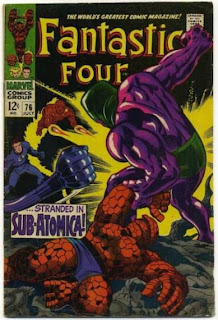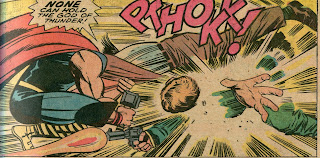FANTASTIC FOUR #75
Galactus can’t locate the Silver Surfer anywhere on Earth. Presuming that the FF knows where the ex-herald is hiding, he sends three “soulless replicas” of Reed, Ben and Johnny to attack them.
Our heroes manage to beat the replicas, but Galactus follows this up by threatening to slam a planetoid into Earth. With no other options left, Reed agrees to find the Surfer.
But where is the Surfer? Using on of Reed’s new experiments, he’s shrunk himself down to subatomic size and is hiding out in a microscopic universe. Fortunately, if anyone just happens to have a vehicle handy for following someone into a microscopic universe, its Reed Richards.
This story arc continues to be yet another classic—unfolding rapidly with multiple plot twists that make perfect sense within the context of a comic book universe. Everything that happens adds excitement, drives the story along, AND provides Jack Kirby a chance to let his visual imagination run wild.
But—hey—do I finally have a chance to say something other than “Jack Kirby is perfect?” The story here is wonderful, but the cover art is a little bit too static to be satisfying. Something more action-oriented and awesome-looking (maybe a wide shot of the FF fighting their duplicates) might have been better.
Still, considering how awesome the interior art looks, I think we can be forgiving.
SPIDER MAN #61
Gwen realizes her dad has been brainwashed—but that same brainwashing forces him to refuse her suggestion that he turn himself in. So she goes on the lam with him.
But it’s too late. Spider Man takes out one gang of thugs that’s looking for them, but another two goons find them and take them to Kingpin’s new hideout.
The hideout is in an out-of-the-way lab at Norman Osborne’s factory, since the rogue scientist who built the brainwashing machine works there. The scientist was using his connections there to get the equipment he needed—a nice bit of background logic typical of Marvel Comics at the time
That sort of thing always reminds me of the classic 1941 Superman cartoon Mechanical Monsters. The mad scientist in that one is using his huge robots to rob banks and jewelry stores. But if he had the resources to build a dozen huge robots and a large mountain lair stuffed with obviously valuable equipment, then why the heck does he need to rob banks?
Of course, that cartoon really is a classic—perhaps the most iconic of the Fleischer series. But I always appreciate it when writers of superhero fiction provide us with at least the bare bones of an explanation for where bad guys get all their cool stuff.
The best “where do they get their stuff” explanation in comics history, I think, comes from Avengers #195. That’s the first appearance of Taskmaster, who runs a henchman school. It was a truly brilliant idea. Where do supervillains get their endless supply of disposable henchmen? From Taskmaster’s school, of course. (I’ll have to review that issue soon.)
I’ve gone off on a weird tangent here, so back to the main story: Kingpin uses Stacy and Gwen to lay a trap for Spider Man. But Spidey comes prepared this time, wearing a filter mask that prevents Kingpin’s tie-pin gas spray from affecting him. Spidey gets the drop on the Kingpin, but only the intervention of Norman Osborne allows him to save the Stacys. The brainwashing machine explodes and, though Kingpin escapes, Stacy’s mind is free again and there’s enough evidence to clear his name.
So everyone’s happy. Well, everyone but Peter, who still figures he’s in the doghouse with Gwen.
Also, we get some foreshadowing that poor Norman may be on the verge of regaining his memory of being the Green Goblin. It’s actually quite awhile before that actually happens, but it’s yet another effective bit of storytelling.
Actually, because it is a few years of real time before the Goblin returns, I wonder if Stan Lee was definitely planning on using him at this point, or if he was just hinting at it “just in case?”
THOR #153
If anyone had been wondering how Loki had even lifted Thor’s hammer in order to steal it at the end of last issue, that’s explained very quickly in this issue. It’s because Loki had also stolen part of Karnilla’s mystical Norn power.
Actually, I get the feeling that Stan and Jack had realized that this plot hole existed and stuck in a few lines of dialogue here to cover themselves. But even if that’s true, it’s a good enough explanation. Thor is the sort of book where simply saying “It’s Magic” can be a perfectly legitimate way of carrying the plot forward.
Karnilla zaps Thor and Sif back down to Earth to pursue Loki, just as Thor reverts to being Don Blake. Loki blasts down Sif with some Norn magic, but Blake manages to catch hold of his hammer (actually, it’s his walking stick at the moment) and turns back into Thor. This leads to some typically awesome Kirby fight scenes.
Thor subdues Loki, but then has to leave him to turn back into Blake again so he can treat the badly wounded Sif. This allows Loki to later attack the hospital O.R. in which Blake is operating on Sif. Blake finishes the operation in the nick of time, turns back to Thor yet again. He and Loki go at it a second time. But Odin, who is now concerned about a new threat approaching Asgard, breaks up the fight with an Odin-Bolt.
That new danger, by the way, is foreshadowed by a few panels of Ulik catching hold of a ledge as he falls down the bottomless pit (Thor, remember, threw him in last issue.) He pulls himself into a cave, where he finds… well, we’ll find out about that next issue.
And this pretty much finishes up a story line that began in Thor #145, when Odin stripped Thor of his powers. It’s been a unique story arc, moving from one plot point to another—amnesia, the Circus of Crime, Loki, the Wrecker, the Destroyer, Ulik, then Loki again. It’s jumped from Asgard to Earth to the Norn realm. It covered a lot of ground without really having a single strong story line running through the whole thing.
But, despite that, it’s a great arc. It never seems like it’s meandering, but rather logically moving from one threat to another as events unfold. The art is powerful, the characterizations (other than Odin’s questionable reasons for de-powering Thor) are consistent with the characters and Thor, Balder, Odin and Sif are all given their appropriate Crowning Moments of Awesome.
I’ve talked about story construction several times recently, but I’m afraid I gotta do it again. The last eight issues jumped around a lot between plot points and from one location to another quite often, but it’s all done with skill. Transitions are always smooth and we never have any trouble at all following along. Stan and Jack’s respective skills at basic story construction continue to stand out.
That being said, I do think I’ll bring up one minor quibble. I honestly think that Stan and Jack have forgotten that Thor’s been out on bail for most of this story arc—accused of helping the Circus of Crime rob a museum. Unless I missed a line of dialogue (or I’m forgetting something that happens in an upcoming issue), Thor’s arrest is never mentioned again nor brought to resolution. Oh, well, I suppose after you save New York City from a supervillain and an indestructible robot, you just might get a few charges against you dropped.
Besides, Thor’s soon going to be too busy saving the universe yet again to make his next court date. We’ll be segueing smoothly from one great story arc into another when a creature with the strength of a “Billion Billion” people raises his rather butt-ugly head.
That brings June 1968 to an end. In July, the Fantastic Four take a Fantastic Voyage; Spider Man meets an Inhuman; and Thor gives some of those darn hippies a good talking to.
By the way, the Superman cartoon I mentioned earlier really doesn’t relate to any of the comics, but it’s such a cool cartoon I think I’ll embed it here anyways. Enjoy.
























































